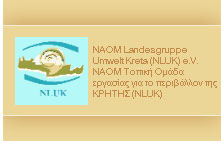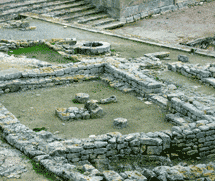
![]() Informationen
Informationen
![]() Informations
Informations
![]() Πληροφορίες του NLUK
Πληροφορίες του NLUK
Copyright © 2022 Kreta-Umweltforum
History of Crete / Archaeology
The history of the „cradle of Europe“ is more than 8,000 years old,
proved by archaeological findings from the late Neolithic at Crete. If „
Minos“ is not only a title, used by all Kings in
Crete, for the Greek historians the mythical King Minos
is the representative of the early Crete.
Even the time past the Minoan period was formative for
the cultural development of Crete documented by archaeological findings. Ancient
followed the Dorian era, hereafter the Roman and Byzantine period – finally
the Ottomans (Turks) followed the Venetian era. (Leaflets 32 & 33)
All of them left marks to be found at Crete at every corner. Our Leaflets will
report about known and unknown archaeological sites in Crete while our focus is
based on the unknown sites.

Plan of a building within the excavation complex in Festos (South Crete)
Leaflets
G. Plath: The correlations of Kommos and Agia Triada under aspect of coastal alterations.
032-04/E - Eras of cultural development of Crete 033-04/E - Eras of cultural development of Crete II
005-04/E - Hiking on the table mountain Patéla
013-04/E - Prehistoric stone pit
021-04/E - The mystic Labyrinth
031-04/E - Excursion to the Aqueduct
049-04/E - Excursion to the necropolises of Armeni
051-04/E - Archaeological ruins and cisterns of Eleftherna
058-04/E - Minoan human sacrifice /
The Epimenides paradox
059-04/E - Minoan settlement places in Gouves and Panormo
060-04/E - The ancient Górtis
061-04/E - "Ravages of time"
(Faneromenis)
062-04/E - Medieval village Etía
074-05/E - The ancient Faistos
075-05/E - Minoan settlement Gournia
080-05/E - Venetian ruin at Demati
086-05/E - The occupation of Crete during World War II - Operation "Mercury"
090-05/E - New grave find (with animals as burial object) in the Lassithi
099-05/E - Frangokastello: a fabled fort
102-05/E - The ancient Ìtanos / Vai
103-05/E - The ancient "Roussolakos"
104-05/E - The ancient Falásarna
118-05/E - "Cyclopean" wall and "megalithic" remains on Crete
125-05/E - Ancient graves at "Lappa" (Agriroupoli)
126-05/E - Minoan necropolis at Maroulas / Sacrilege on cultural assets
127-05/E - Minoan tholos tomb at Maleme / Northwest Crete
141-06/E - Minoan settlement NIROS in Vathianos Kampos
183-06/E - 2 Minoan archaeological sites at Archanes
191-06/E - Tholos tomb near Margarites
206-07/E - 2 ancient mansions in Makrygialos (South Crete)
Minoan and Roman building complex
223-07/E - Archaeological place in Limensa Chersonisos
(Roman and Byzantine relicts at the tourist village)
227-07/E - Roman Wall (Aqueduct) by Kastamonitsa / Lyttos
228-07/E - Villa of the Lillies & Sanctuary of Zeus Thenatas in Amnissos Antiquities
308-09/E - The mountain fortress Koules at Magarikari
309-09/E - The Venetian Fort "Kazarma"
in Sitia
312-09/E - The War museum in Askifou
325-10/E - Bunker from World War II at Vamos
329-10/E - The Minoan archaeological excavation site Phourni
335-10/E - The archaeological site Vassiliki
342-10/E - Praisos,
the old town of the Eteocretans
355-11/E - Military Museum in Chromonastiri
363-11/E - Crete in Greek mythology (1)
366-12/E - Aptera: stony witnesses of Crete's history
378-12/E - The Minoan Villa Niros
386-12/E - The ancient town Lyctos (Lyttos) by Kastelli / North Crete
404-13/E - First bishop of Crete:
the Holy Titus
405-13/E - Greeks were the 1st operators of beacon fire
410-13/E - About the history of the architectural culture of Crete
703-22E - Kamara in Agios Nikolaos
